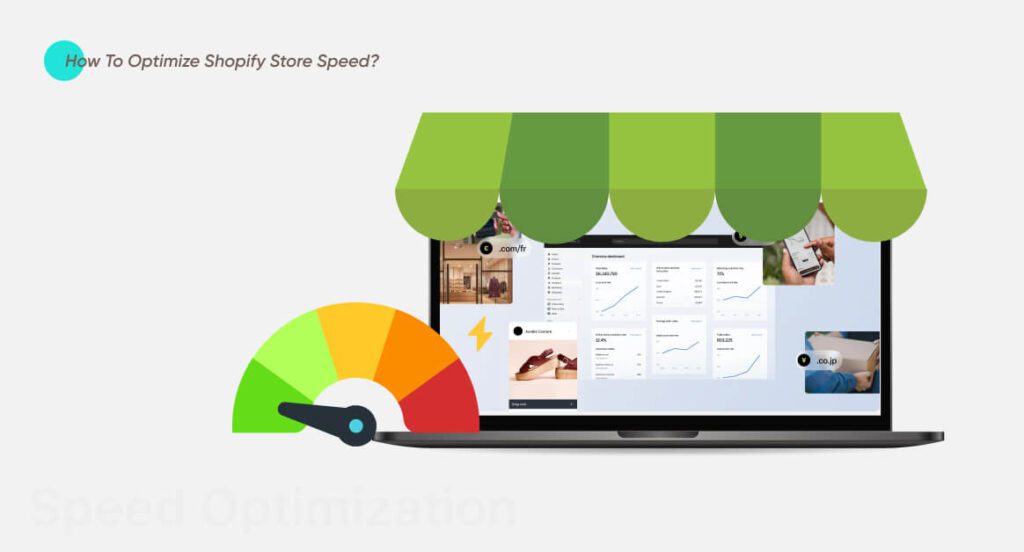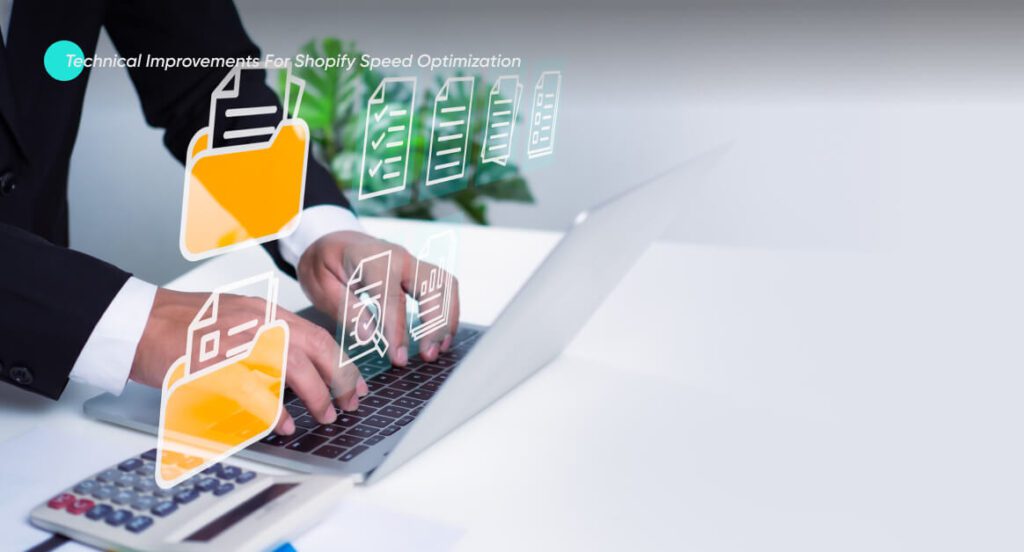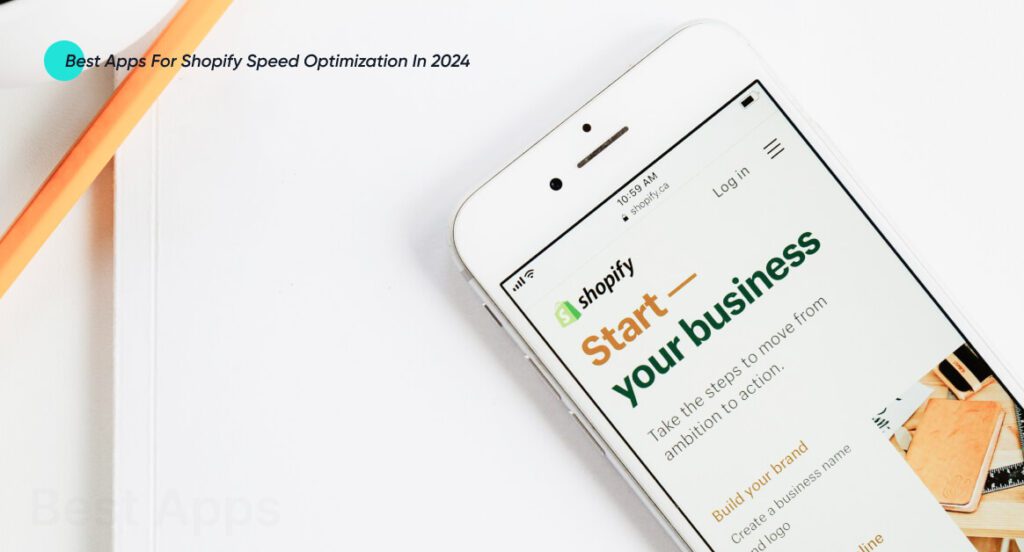Shopify Speed Optimization
Your Shopify store speed directly impacts your performance and customer experience. Slow loading times often lead to frustrated customers, who might abandon their carts and choose your competitors over you. Hence, neglecting Shopify speed optimization can not only position you as a subpar store but also push your customers to your competitors.
Recent SEO updates have categorized page speed as an integral factor for better rankings. Google says the ideal load period should be 2 seconds or less. Our experts advise that we aim for 1.5 seconds on a desktop and 1 second on a mobile device. Shopify optimization gives you a competitive advantage on this front. Moreover, it increases conversions by approximately 27%, builds customer loyalty by improving customer satisfaction, and considerably improves SERP rankings.
This comprehensive guide will walk you through proven tips and tricks, site speed factors, and technical improvements for a faster Shopify store. Let’s begin!
What Speed Optimizations Does Shopify Already Have?
Shopify comes with certain speed optimizations. Other eCommerce solutions aren’t as fast and optimized as Shopify sites are. After you’ve created your store, you need to ensure that the following performance features are already implemented:
Browser Caching – Shopify already caches your site’s internal resources. This helps store some of your website content locally within a user’s browser. This includes images, videos, JavaScript, and CSS. This facilitates users because they won’t have to download the same content twice. It can also speed up your store because users can access some content before the other content loads.
Content Delivery Network (CDN) – Shopify’s CDN helps store some of your content on servers around the world. Hence, the physical distance between the site’s content and the user is reduced considerably, improving site performance.
How do you test the speed of your Shopify website?
There are many tools available for Shopify site speed optimization. Moreover, it has its online store speed dashboard; it can easily be used to assess the load time for any storefront and compare it to competitors. You can also use third-party testing tools or open your site URL on multiple browsers, networks, and devices.
How to optimize Shopify store speed?
Here, we have listed some tips to help you optimize your Shopify store speed:

1. Minimize Redirects
Redirects instruct browsers to go to a URL different than the user requested. For example, if the user wants to check a specific product from your catalog but it’s out of stock and you’ve removed its webpage, you can set a redirect to send the user to your main products page to explore other products. This is a popular practice in e-commerce today. Many brands use this to improve the overall user experience by ensuring users don’t get a 404 error.
However, you need to ensure that you do it correctly. You can consult an expert if need be. If you don’t, you can damage your brand image, slow down your website, and confuse Google’s crawlers. However, pay special attention to redirect chains and redirect loops.
2. Disable Unused Apps and/or Features
When you download any apps or features for your shop, they add some code and script to your Shopify store so they can run. But if you’re not using them, their code keeps running in the background, slowing your site performance.
Shopify recommends that you use a maximum of 20 apps. If you have more apps than this, go to your Shopify store to see which apps are not being used at all and remove them. Moreover, your site might also have some features you don’t use. Remove them.
If you feel confused when deciding which apps and features to keep, ask yourself which will facilitate you as a customer and make you go for a purchase.
3. Image Optimization
High-quality images usually have a large file size. When a user loads your website, their device must download these large files from the server. These files take a lot longer to download. If the user has a slower internet connection, it can take forever to load and adversely impact the user experience.
Moreover, each image requires a separate hypertext transfer protocol (HTTP) request to the server. Hence, more images mean more requests to the server load and greater data transfer time. Here are some image optimization tips:
- Don’t use GIFs. Use static images.
- Compress images to reduce the file size without losing quality.
- Lazy load images if need be. This is a great way to load images only when the user needs it.
- Use fewer images. Customers don’t need tens of images to understand your product. Just a couple of pictures from the right angles are enough.
4. Theme Optimization
Shopify themes are designed to be lightweight and fast. However, when you customize it to your brand and Shopify store preferences, you might alter it to such an extent that it becomes slow and bloated. Here is what you can do for Shopify page speed optimization:
- Avoid making too many customizations, especially requiring additional scripts or heavy resources. Try to use the built-in features and keep custom changes to a minimum.
- Ensure that your theme is updated. The latest versions of themes are mostly optimized.
- Only showcase the essential elements on the homepage. Avoid cluttering.
5. Choose the Right Font
Your fonts can be classified into two broad categories:
System Fonts – Fonts that are already installed on a user’s computer. They are standard, web-friendly, and compatible with operating systems and applications.
Web Fonts—Fonts that must be downloaded on the user’s computer. They are more visually creative but can slow the website by adding extra requests and blocking rendering.
Some fonts you can use to avoid slow loading times for your website include Menlo, Times New Roman, Monaco, and Georgia.
6. Reduce HTTP Requests
HTTP requests are messages that a web browser sends a web server when someone wants to view your website. These requests can be for any content. The greater the number of files on the website, the higher the number of HTTP requests the browser needs to load them all. This makes the website slower. Here’s how you can reduce the number of HTTP requests:
- Remove unnecessary buttons.
- Stick to simple designs for your Shopify website. Complex animations or design elements demand additional code and resources.
7. Host Videos Externally
If you’re using videos to showcase your products for better user engagement, it might be impacting your site speed directly. Putting every single video directly on your website increases load times because the users are loading them directly from your website’s server. This creates user frustration and often leads to customer hopping.
Hence, if you’ve listed your products like this, your best bet here is to host all your Shopify product videos externally. You can use YouTube, Vimeo, or any other platform. Upload the video here and embed the link in your store. Consequently, you can enjoy a dynamic store and capture consumer attention without compromising store speed.
8. Use Hero Layout
If your store’s homepage has various features, there is a huge chance that you’ll probably be using a carousel or slider. While there isn’t anything wrong with using them, it’s best to avoid them because they have low click-through rates, increase loading times, and sometimes lead to an unresponsive website.
Hence, choose a static Hero image layout instead. They are a great way to improve Shopify site speed. Use one high-resolution image and a dedicated CTA instead of a slider or carousel.
Technical Improvements for Shopify Speed Optimization

Now that you know some of the basic tips and tricks for Shopify speed optimization, let’s dive into some technical improvements as well:
Use Accelerated Mobile Pages (AMP)
More than 50% of all Shopify users are dedicated mobile shoppers. AMP pages are essential for capturing this market and providing a good user experience. They are great for improving mobile usability and load times. However, moving your eCommerce website to AMP can be challenging and might impact your store’s design. Hence, consult an expert for better insight.
Remove Render-Blocking CSS and JavaScript
The loading order of scripts is an essential component of web development and ensures smooth rendering and functionality.
- Start by loading HTML files. They will provide the overall structure of the website as well as the content of the webpage.
- The load CSS files. They will style the HTML content and ensure your website is presentable to users.
- Load JavaScript at the end. They add interactivity and dynamism to your webpage.
Revise your JavaScript, CSS, and HTML
Hire a professional to overview and revise your JavaScript, CSS, and HTML scripts to remove any and all unnecessary parts of the code.
Use Google Tag Manager
When you add apps to your Shopify store, they add tags to track actions. Hence, the greater the number of apps installed, the greater the number of tags attached. These tags add up quickly and can slow down your store. Hence, you can migrate tracking codes to Google Tag Manager to optimize this process.
Sort Any Unnecessary Page Elements
Users won’t interact with every single element on your webpage. Hence, monitor on-page activity and see if users scroll down to see images, videos, and other visual elements at the bottom of the page. If not, your best bet is to remove them for Shopify optimization.
See our latest relevant exploration Shopify Redesign: Revamping Your Store for Success ![]()
Best Apps for Shopify Speed Optimization in 2024

If you’re serious about Shopify optimization, you should consider downloading helpful tools and applications from the Shopify app store. They are very simple to use and have many diverse features for better optimization.
Here, we have listed this year’s best apps for Shopify speed optimization. We have meticulously looked into their reviews, top features, and other subjective parameters before listing them here.
1. Booster: Page Speed Optimizer
Stars – 4.7 | Reviews – 1270+
This Shopify app helps you improve the performance of your webpage. Improved webpage performance aids SEO and improves conversions. Booster is an ideal application for entrepreneurs wanting an optimized Shopify store without paying a fortune.
Benefits of Booster: Page Speed Optimizer
- It offers instant optimization and makes all web pages load faster than before.
- It has an interactive dashboard that presents your website’s critical information.
- Booster is easy to use. You can get started with the app in just a few minutes. You don’t need coding knowledge prior.
Pricing
Booster offers its services for free. With its package, you can access all its basic and premium functionalities.
2. Tapita SEO & Speed Optimizer
Stars – 5.0 | Reviews – 1500+
Tapita is excellent for analyzing your SEO and page performance. It tracks current load times and lets you know if your store is falling short anywhere. It helps improve SERP rankings. Moreover, this app is a speed booster and image optimizer. Moreover, it aids in SEO audit, metadata templates, Google Schema, broken links, page indexing, sitemaps, keyword research, etc. Tapita is best for entrepreneurs who want to track their store performance on the go.
Benefits of Tapita
- It tracks your website’s performance and improves its profitability and speed.
- You can monitor the performance of your competitors.
- You can get personalized recommendations and insights regularly.
Pricing
Tapita is free to install. You get free Boost SEO features and Shopify speed optimization; however, extra charges may apply for other services.
3. Hyperspeed: Extreme Page Speed
Stars – 4.9 | Reviews – 200+
Hyperspeed offers better load times and higher conversions for your Shopify store. It helps you advance your website and reduce any lags or glitches.
Benefits of Hyperspeed: Extreme Page Speed
- Hyperspeed improves the store’s load times with the help of LazyLoad and Critical CSS inlining.
- You can pick from several pre-set optimization levels for the best experience.
- You can keep all page optimizations updated via its dashboard.
Pricing
Hyperspeed’s full package is worth $49/month. It gives you access to app caching, page preloading, critical CSS inlining, hyperscripts, and lazyload.
4. AVADA Image Optimizer
Stars – 4.9 | Reviews – 5960+
If you use many high-resolution and large images on your website, you’ll be compromising page load times. You should compress them for a better user experience. Compressing your images doesn’t impact the overall quality of your images; it just makes the load faster on the webpage. AVADA Image Optimizer is one of the best image optimization apps.
Benefits of AVADA Image Optimizer
- AVADA automatically optimizes your images.
- It adds unique alt tags to all the images, whether from products, collections, or blog pages.
- It can easily integrate with other Shopify apps.
Pricing
AVADA Image Booster offers its services for free. Entrepreneurs struggling with page load times because of high-resolution images should definitely use it.
5. Loadify: Preloader & Speed Ups
Stars – 4.7 | Reviews – 150+
Loadify is a great way to keep users entertained during loading screens. It offers appealing page transitions and can bluff a customer into thinking your website is much faster. The app’s UI is mobile-supported; hence, you can change your smartphone or tablet via the Shopify app. It is ideal for entrepreneurs who want smooth page transitions.
Benefits of Loadify: Preloader & Speed Ups
- You have access to pre-selected optimized images.
- You can customize a transition animation depending on your store’s needs.
- You can successfully reduce all the unnecessary script loads in a few seconds.
Pricing
Loadify offers different plans for entrepreneurs to choose from:
- Basic Preloader – Free. Offers 15 speed-optimized GIFs, a lite preloader setting, advanced support, and is compatible with any theme.
- TurboMode Boosts – $3.99/month. It offers LazyLoad and LinkPredict and boosts page load and support.
- Page Transitions – $3.99/month. It offers four types of transition animations, unique customization options, a lite preloader setting, and advanced support.
- Custom Preloader – $4.99/month. Offers logo animation, fade-out speed, custom upload, lite preloader setting, size and BGR color adjustment, and advanced support.
6. SEOAnt ‑ AI SEO Optimizer
Stars – 4.8 | Reviews – 970+
SEOAnt is a special multifunctional app with image compression, search engine optimization, page speed development, and other SEO features. It is ideal for businesses who want to ensure that they are SEO-sound.
Benefits of SEOAnt ‑ AI SEO Optimizer
- You can receive a detailed SEO check report for your entire Shopify website.
- Users can find expert services to improve their page speed.
- You can improve on-page SEO and ensure better SERP rankings.
- You can quickly fix any meta issues by using the Automate Bulk Editor.
Pricing
It offers two pricing plans:
Free Plan – Offers On-page SEO (20 products), auto compressing for 50 images, SEO checker, alt text editor, and keyword suggestion tool.
Pro Plan – $29.99/month. You get everything on the free plan, including on-page SEO for 1000 products, auto compress for 2000 images, search console, meta tags edit, and JSON-LD.
Shopify Site Speed Factors You Can’t Control
While you can control most of your Shopify store, you can’t fix everything. Here are a few factors that impact your Shopify site speed but you can’t control them:
- You can’t control local and server-side caching.
- You can’t control your customer’s device and their internet connection.
Conclusion
If you want to ensure a seamless user experience, boost conversions, and stay competitive in the e-commerce industry, you must invest your time and resources in Shopify speed optimization. Using the tips and tricks we’ve listed above will give you a sure shot at achieving this bottom line. Moreover, the technical improvements discussed are a great way to elevate an already optimized store.
With the right tools and professionals, you can meet Google’s standards, enhance SEO rankings, and provide an optimized shopping experience for customers in the long run.
Frequently Asked Questions (FAQs)
Your Shopify website can be slow for several reasons, including unoptimized images and videos, unnecessary or unused apps, heavy themes and fonts, large image files, conflicts between apps and themes, and inefficiencies or conflicts within themes’ code and complex animations or design elements.
Shopify Plus boasts faster API calls and enhanced development possibilities, facilitating seamless integration with other apps for efficient growth. Its user-friendly automated workflows streamline operations for large-scale businesses. While it is pricier, Shopify Plus offers dedicated account management, advanced features, and unlimited staff accounts, making it ideal for rapidly expanding businesses that are seeking to optimize their e-commerce capabilities and scale operations.
Your Shopify speed score reflects how quickly your store performs in a test setting using Google Lighthouse performance data. A good Shopify speed score is greater than 50, while speeds greater than 70 are excellent!
Masifa is a Content Specialist with a bachelor’s degree in marketing and over three years of experience in content marketing and the IT industry. She is passionate about writing and talking about website and mobile app development, e-commerce, and advancements happening in the IT Industry. She creates engaging and user-centric content to optimize digital experiences for these niches. When she is not creating content, you can find her buried in a good book.